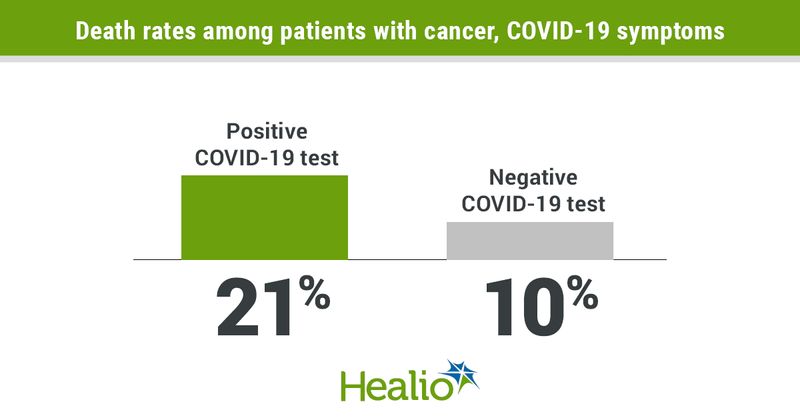Patients with cancer, COVID-19 symptoms may be at higher risk for death
Individuals with cancer who presented with symptoms of COVID-19 demonstrated high rates of 30-day mortality whether they tested positive or negative for the virus, according to results of a study published in European Journal of Cancer.
“The death rate of [patients with COVID-19] is reported to be close to 2%. [Patients with cancer] are a group at higher risk for serious and lethal complications of COVID-19,” Souad Assaad, MD, medical director of Centre Léon Bérard in France, and colleagues wrote. “The 30-day survival of patients with cancer presenting with documented COVID-19 has been reported to be 60% to 70% in recent series. These results were reported in particular from a large oncology hospital in China and were compared with patients with COVID-19 without cancer. Variability in death rates has been reported across countries and within countries, possibly related to differences in screening strategies but also different population susceptibility.”

The retrospective PRE-ONCOVID-19 study aimed to determine the clinical characteristics and outcome of patients with cancer who presented with suspicion of COVID-19 to identify factors predictive of unfavorable outcome.
Assaad and colleagues pooled data on 302 patients with cancer admitted to Centre Léon Bérard between March 1 and April 25 with clinical symptoms of COVID-19 and/or suspicious images on CT scan. Researchers used a web-based tool within electronic patient records to gather data on patient characteristics, symptoms and survival, and compared outcomes among SARS-CoV-2 real-time or reverse-transcriptase polymerase chain reaction (RT-PCR)-positive (n = 55) and -negative patients (n = 247).
Of the nasopharyngeal samples analyzed, 18.2% had detectable SARS-CoV-2. Those who tested positive were more likely to be older (mean age, 63.8 years vs. 56.9 years) and have hematologic malignancies (36.4% vs. 19.4%), respiratory symptoms and suspected COVID-19 pneumonia on CT scan (67.5% vs. 20%).
More than one-third (38%) of those with a negative test presented with respiratory symptoms and 20% had CT scan results that indicated COVID-19 pneumonia.
Median follow-up was 25 days.
Researchers reported death rates of 9.9% overall (n = 30), 21% among patients with a SARS-CoV-2 RT-PCR-positive result and 10% among those with a negative result.
Mortality rates for patients with respiratory symptoms or COVID-19-type pneumonia on CT scan were 18.4% among patients who tested positive and 19.7% among those who tested negative.
Most patients who died (80%) had metastatic cancer.
Independent risk factors for death included male sex (HR = 2.75; 95% CI, 1.91-3.59), Karnofsky performance status less than 60 (HR = 4.87; 95% CI, 3.87-5.87), cancer relapse (HR = 3.05; 95% CI, 1.83-4.27) and respiratory symptoms (HR = 5.09; 95% CI, 4.11-6.07). None of the cancer treatments administered within the previous month was associated with survival outcomes, researchers noted.
“The results obtained in the PRE-ONCOVID-19 study show that only a minority, 18.2%, of [patients with cancer] presenting with clinical symptoms of COVID-19 had demonstrated SARS-COV-2 with RT-PCR performed on nasopharyngeal samples,” Assaad and colleagues wrote. “Specific therapeutic procedures suggested to improve COVID-19 patient survival ... should be investigated also in COVID-19-negative patients with cancer presenting with severe symptoms suggestive of COVID-19.”
